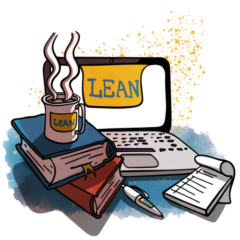-
How it works
How does it work?
Dmaic.com offers comprehensive and fully accredited online Lean training.
Read more Online packagesOnline trainingClassroom trainingsClassroom and in-company training
Online packagesOnline trainingClassroom trainingsClassroom and in-company trainingDmaic.com also offers classroom Lean and Lean Six Sigma training courses Read more
- Pricing
- Companies
- Knowledge
 Knowledge baseWant to know more about Dmaic and what Dmaic means for other companies? Check the Dmaic.com knowledge base.
Knowledge baseWant to know more about Dmaic and what Dmaic means for other companies? Check the Dmaic.com knowledge base. Online WorkshopsDon't immediately choose a course for you: do you want the knowledge and tools with which you can get started right away? Then a Dmaic-workshop is for you.
Online WorkshopsDon't immediately choose a course for you: do you want the knowledge and tools with which you can get started right away? Then a Dmaic-workshop is for you.- About
The Logical Thinking Behind Lean Methodology
Lean Methodology: Beyond a Buzzword
Lean methodology transcends being just a buzzword; it embodies a mindset. At its core, Lean is fundamentally about logical thinking. This practical approach aims to deliver maximum value to customers by eliminating waste and inefficiency at every step. In doing so, it not only serves the customer but also drives business success. Let’s explore the logical principles at the heart of Lean methodology and their application in today’s businesses.
Customer-Centric Approach: The Heart of Lean
At the heart of Lean is a customer-centric philosophy. Understanding customer needs is critical for setting appropriate goals and aligning processes. This customer-focused logic is the foundation of Lean. Value creation is a journey, achieved through a combination of well-executed steps like marketing, design, production, service, delivery, and support. It culminates in products and services that customers truly value.
Striving for Perfect Processes
The journey of Lean methodology begins with a simple yet profound principle: the pursuit of perfect processes and performance. ‘Perfection’ here doesn’t imply an unreachable ideal but signifies a continuous effort to optimize processes. Closer to perfection, processes provide greater value to customers, leading to enhanced satisfaction and business success.
Value Creation as a Process
Value creation in Lean is not just a result but a comprehensive process. It involves crucial steps such as marketing, design, production, service, delivery, and support. Each step must be performed effectively to create a valuable product or service for the customer. Imperfections like delays and inefficiencies represent waste, hindering this process. Achieving near-perfect processes means optimal delivery of value, leading to greater customer satisfaction and business success.
The Human Element in Lean
Lean methodology recognizes the pivotal role of people in the value creation process. They are the ones who implement processes, harnessing technology and equipment. Building a Lean culture means fostering an environment where people are engaged, innovative, and committed to value-adding activities.
Process-Driven Strategy in Lean
In Lean, every process is viewed as having inputs, activities or sub-processes, and outputs that ultimately benefit the customer. This logical structuring facilitates the identification and elimination of waste and inefficiencies, streamlining operations for better delivery of customer value.
Conclusion: Lean Logical Thinking
In essence, Lean methodology is a form of applied logic focused on continuous improvement. By honing processes, understanding customer needs, and promoting value-adding activities, Lean logically steers businesses towards enhanced efficiency and customer satisfaction. Remember, the core of Lean is logical thinking. Embracing its logical principles provides a roadmap for efficient and effective value delivery.
Become a Lean Expert on Your Schedule: Discover Our Flexible Online Lean Green Belt Training
Ready to finally take a Lean course at your convenience? Look no further! Our online Lean Green Belt training is tailor-made for busy professionals like you. Master the intricacies of Lean methodology at your own pace and from the comfort of your home. Sign up now and take the first step towards becoming a Lean management expert!
Start Your Lean Journey Today!

